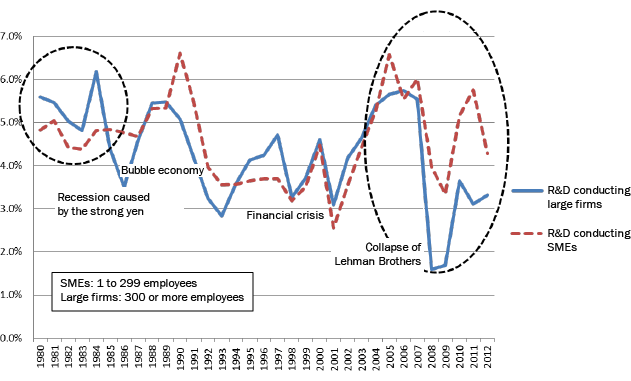Reversed profitability between large firms and SMEs conducting R&D
It is common knowledge that large firms have higher profitability than small and medium-sized enterprises (SMEs). Yet, among firms that conduct research and development (R&D), SMEs have demonstrated higher profitability (profit-to-sales ratio) than large firms in recent years, as shown below in the Figure (Note 1). (A similar trend is observed across all the industries covered in the Report on the Survey of Research and Development compiled by the Statistics Bureau, Ministry of Internal Affairs and Communications. However, due to long-term changes in the non-manufacturing sector covered by these statistics, the figure below is based solely on manufacturing sector data.)

In the early 1980s, when Japanese firms enjoyed strong international competitiveness in a relatively stable economic environment, large firms boasted higher profitability than SMEs even among those engaged in R&D. However, the relative positions fluctuated in the period of economic turbulence over a series of events including the 1985 Plaza Accord, recession due to the strong yen, the emergence and collapse of an economic bubble triggered by the monetary policies, and Japan's financial crisis. Over the period since 2005, which covers the collapse of Lehman Brothers, the profitability of R&D-conducting large firms has dropped to a level below that of SMEs. Among firms that do not conduct R&D, both large firms and SMEs continue to suffer from low profitability, with their relative positions fluctuating randomly with no clear trends.
Today, amidst a growing recognition of the importance of innovation, why has profitability by firm size reversed among firms conducting R&D?
Significance of leadership in SME management
Generally speaking, SMEs have a different management style than large firms. Many SMEs are under the powerful leadership of top management, while large firms tend to delegate authority of power to individual departments and introduce complicated in-house procedures for consensus-based corporate decision making. Greiner's model for organizational growth (Note 2) states that a small company uses centralized management where a strong leader judges and commands every issue, however, as the organization grows, it needs to delegate authority to its departments. Moreover, it needs formal systems to coordinate all departments through budgets, human resources (HR) allocation, business planning, and HR evaluation by the head office staff.
The advantage of these two management styles might have changed due to the economic environment surrounding firms. Compared to the early 1980s, we now live in "dog years," the age of innovation and globalization with a fast-changing business environment. To cope with the rapid pace of changes, agile management by top leadership might have gained advantage. In other words, this management style allows top management to make bold decisions to challenge a new business and adjust the firm quickly based on market response. Top management is responsible for both R&D strategy and business strategy, and therefore maintains its consistency. Top management negotiates with other firms or universities, and therefore can make a speedy decision on strategic partnerships for open innovation. Langlois (2007) (Note 3) pointed out that smaller specialized organizations with other business partners had gained greater advantages in recent years, and that the importance of entrepreneurs had been reinstated.
Open innovation by ambidexterity of the two management styles
At the same time, the management style of large firms has its advantages. Japanese firms have long been known for their kaizen improvement method that realizes high-quality products at low costs by taking advantage of on-site strength. For this, a management style with a "bottom-up" approach and in-house coordination is indispensable. Even today, in a relatively stable market for existing businesses, it is very effective to carry out in-house considerations thoroughly to reduce risk. Since 2012, the last year of the above mentioned statistical data (Note 4), the profitability of large firms has dramatically recovered. As seen in the example of bakugai (massive shopping in Japan by international visitors), there is a strong demand from overseas for high-quality Japanese products.
However, the sole use of the conventional large-firm management style is insufficient because of necessity for dealing with high-growth markets of new industries as well as stable markets. New markets under rapid changes inevitably are carrying risks and uncertainty. Additionally, it is said that the risk for "not taking on new challenge" in this area is greater than the challenges themselves (Note 5) (Note 6). The study of management of technology (MOT) also points out the necessity for simultaneous use of two styles of management for incremental innovation and radical innovation, although they are completely different (Note 7). The key to profitability would be the combined use of the large firm management style and the SME management style which is driven by leadership.
In 2016, the Japanese economy will face a high degree of uncertainty in terms of the international environment as well as business models such as IT use. The only certainty would be the intensiveness of changes ahead, bringing in major risks and major opportunities at the same time. Under such circumstances, open innovation would be crucially important to combine the strengths of large firms and SMEs with strategic partnerships. Fortunately, Japan is blessed with low-interest rates in the financial markets, superb technological capacity, and excellent human resources. It is expected for Japan's business to challenge actively opportunities in the rapidly changing environment, and for Japanese economy to be revitalized as a whole.
Please note that the opinions expressed in this article are mine and do not represent the views of the organizations to which I belong.


